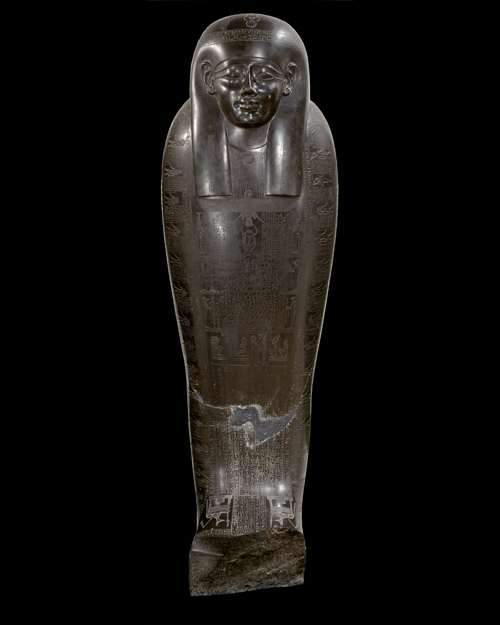
© 2008 Musée du Louvre / Georges Poncet
Uncertain provenance, probably the Saqqara necropolis
Ptolemaic period, 2nd century BC
Graywacke
H.. : 1.78 m; W.: 60 cm; D.: 41.5 cm
Department of Egyptian Antiquities, Musée du Louvre
(D 39)
This sarcophagus was made for a woman named Tanethep. It is made of two parts, one of which nestles inside the other. It is covered with texts from The Book of the Dead, turning the coffin into a three-dimensional version of the book. The specially selected chapters are arranged on the sarcophagus in relation to the parts of the body concerned by the hieroglyphic formulas. The front part has a depiction of Tanethep’s ba in the form of a human-headed bird accompanied by the goddesses Isis and Nephthys who hold, respectively, a veil, the hieroglyph for breath, and hieroglyphs meaning “life, stability, power.” The ba is shown simultaneously flying toward the light but also embracing the body with its hands. The other, inner, side of the cover pictures Nut, goddess of the sky, shown naked and stretching over the deceased. Nut is the celestial counterpart of the goddess of the West, shown inside the other half of the sarcophagus, evoking the land of the dead. The deceased is thus placed between two worlds, like the sun on its daily path, thereby guaranteeing perpetual rebirth. The outer surface of the inner coffin features a depiction of Anubis, god of embalmers, advancing toward a silhouette (the mummy or sarcophagus), accompanied by texts invoking divine protection. These texts, like the ones on the outer cover, can only be read when the coffin is in a vertical position, the one theoretically used for the rite of the “opening of the mouth” in front of the tomb. In contrast, the illustrations of the deities on the sides of the sarcophagus relate to the kingdom of the dead and can only be read once the coffin is placed in a horizontal position. This sarcophagus provides outstanding testimony to the high quality of certain works in stone during the Ptolemaic period and to the persistence of Egyptian funerary beliefs during Macedonian domination.